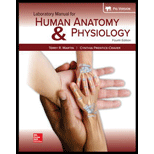
Concept explainers
Introduction:
Embryogenesis is the development of a fetus occurs. In this period all organs begins to develop and start functioning. Embryogenesis occurs after fertilization. When sperm meet to egg to form zygote then zygote starts dividing its cells to form blastula than organogenesis where organ starts to develop.
Answer to Problem 1PL
Correct answer:
The correct answer is an option (b) Development of the embryo and fetus progresses from cephalic toward caudal.
Explanation of Solution
Explanation/justification for the correct answer:
Option (b) cephalic is an embryo head. Caudal is an embryo tail. During the gastrulation period, the development starts from the head and ends with tail and orientation from front to back occurs. So, the correct answer is an option (b).
Explanation for incorrect answer:
Option (a) Development of the embryo and fetus progresses from medial toward lateral. The development of an embryo always occurs from head to tail not from medial to lateral. So, this is an incorrect option.
Option (c) Development of the embryo and fetus progresses from anterior toward posterior. The development of a fetus always starts from head to tail and front to back. So, this is an incorrect answer.
Option (d) Development of the embryo and fetus progresses from inferior toward a superior. The development occurs from head to tail not from inferior toward a superior.
Want to see more full solutions like this?
Chapter 18 Solutions
Laboratory Manual For Human Anatomy & Physiology
- Can you described the image? Can you explain the question as well their answer and how to get to an answer to an problem like this?arrow_forwardglg 112 mid unit assignment Identifying melting processesarrow_forwardGive only the mode of inheritance consistent with all three pedigrees and only two reasons that support this, nothing more, (it shouldn't take too long)arrow_forward
- Oarrow_forwardDescribe the principle of homeostasis.arrow_forwardExplain how the hormones of the glands listed below travel around the body to target organs and tissues : Pituitary gland Hypothalamus Thyroid Parathyroid Adrenal Pineal Pancreas(islets of langerhans) Gonads (testes and ovaries) Placentaarrow_forward
- What are the functions of the hormones produced in the glands listed below: Pituitary gland Hypothalamus Thyroid Parathyroid Adrenal Pineal Pancreas(islets of langerhans) Gonads (testes and ovaries) Placentaarrow_forwardDescribe the hormones produced in the glands listed below: Pituitary gland Hypothalamus Thyroid Parathyroid Adrenal Pineal Pancreas(islets of langerhans) Gonads (testes and ovaries) Placentaarrow_forwardPlease help me calculate drug dosage from the following information: Patient weight: 35 pounds, so 15.9 kilograms (got this by dividing 35 pounds by 2.2 kilograms) Drug dose: 0.05mg/kg Drug concentration: 2mg/mLarrow_forward
- A 25-year-old woman presents to the emergency department with a 2-day history of fever, chills, severe headache, and confusion. She recently returned from a trip to sub-Saharan Africa, where she did not take malaria prophylaxis. On examination, she is febrile (39.8°C/103.6°F) and hypotensive. Laboratory studies reveal hemoglobin of 8.0 g/dL, platelet count of 50,000/μL, and evidence of hemoglobinuria. A peripheral blood smear shows ring forms and banana-shaped gametocytes. Which of the following Plasmodium species is most likely responsible for her severe symptoms? A. Plasmodium vivax B. Plasmodium ovale C. Plasmodium malariae D. Plasmodium falciparumarrow_forwardStandard Concentration (caffeine) mg/L Absorbance Reading 10 0.322 20 0.697 40 1.535 60 2.520 80 3.100arrow_forwardPlease draw in the missing answer, thank youarrow_forward
- Essentials Health Info Management Principles/Prac...Health & NutritionISBN:9780357191651Author:BowiePublisher:Cengage
 Medical Terminology for Health Professions, Spira...Health & NutritionISBN:9781305634350Author:Ann Ehrlich, Carol L. Schroeder, Laura Ehrlich, Katrina A. SchroederPublisher:Cengage Learning
Medical Terminology for Health Professions, Spira...Health & NutritionISBN:9781305634350Author:Ann Ehrlich, Carol L. Schroeder, Laura Ehrlich, Katrina A. SchroederPublisher:Cengage Learning





